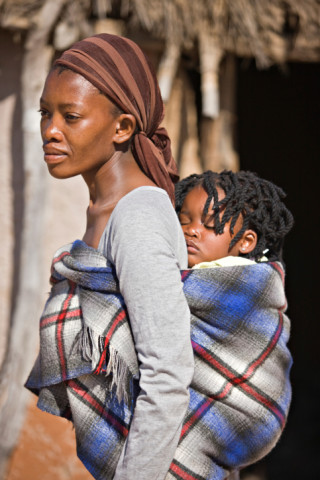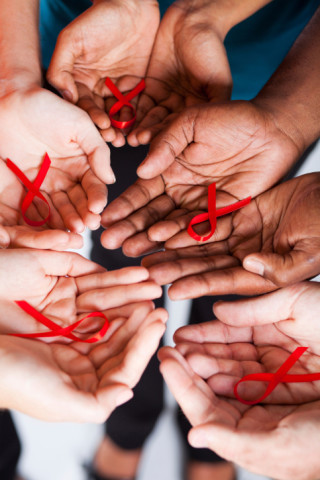 Across the globe, slowly but surely, improving treatments and information for pregnant women who are HIV positive are having an impact. The success can be measured in two ways: first, the number of pregnant women who have access to HIV testing and treatment is rising worldwide; second, the prevention of mother-to-child transmission (MTCT) of HIV is increasing in effectiveness.
Across the globe, slowly but surely, improving treatments and information for pregnant women who are HIV positive are having an impact. The success can be measured in two ways: first, the number of pregnant women who have access to HIV testing and treatment is rising worldwide; second, the prevention of mother-to-child transmission (MTCT) of HIV is increasing in effectiveness.
There was a 58% global decline in new pediatric HIV infections between 2001 and 2013. However, every day nearly 700 babies are newly infected with HIV, often because their mothers and family lack knowledge and access to treatment.
Dr. Laura Guay has been researching HIV treatment and prevention for more than a decade, spending seven years in Uganda, where she worked on a trial to determine the effectiveness of single-dose Nevirapine in preventing MTCT of HIV. The American research professor at George Washington University is also vice president of the Elizabeth Glaser Pediatric AIDS Foundation (EGPAF), a nonprofit organization seeking to end pediatric HIV/AIDS through research, advocacy, and prevention and treatment programs. The EGPAF focuses particularly on those countries with the greatest HIV burden.
Fear, misinformation and stigma
“In the United States and many developed countries with adequate healthcare infrastructure and individualized patient care, there are opportunities to provide HIV infected women with the information they need to make an informed choice about the safest ways to maintain their health and prevent HIV transmission to their infant,” Dr. Guay says. “However, in many resource-limited settings, where the number of HIV infected pregnant women are the greatest, the healthcare infrastructure and workforce cannot adequately address all these issues.”
“In these settings, there is still significant fear, misinformation, and stigma associated with HIV infection that may prevent HIV infected pregnant women from seeking services or accepting antiretroviral treatment during pregnancy.”
Tackling MTCT of HIV is high on the agenda for health workers across the globe. This year, the Ghana government announced the formation of a landmark global consortium charged with eliminating MTCT of HIV in Ghana. Tapping into a range of expertise and technical capacity, the group includes Yale University, IBM, and The ONE Campaign, as well as the Ghana health authority. Despite recent progress in reducing the number of new HIV infections, Ghana is among the 22 countries with the highest levels of HIV among pregnant women. Testing for HIV during pregnancy is under-utilized due to lack of public awareness, limited access to diagnostic tests, and cultural stigma.
Clinical trials need to include more pregnant women with HIV
“The same women at high risk of contracting HIV often have high fertility/child birth rates, due to a cultural expectation that women will produce many children, as well as lack of knowledge about and acceptability of contraceptive use. Therefore, it is even more important that pregnant women are included in prevention and treatment studies with close monitoring of safety and effectiveness,” continues Dr. Guay.
In 2013, the World Health Organization (WHO) issued new HIV care and treatment guidelines that recommend lifelong antiretroviral therapy (ART) for all pregnant and breastfeeding women. As well as improving the health of the mother, this will increase the likelihood that infants born to HIV-positive mothers will be born HIV-negative.
ART could almost completely eliminate MTCT, but gaps remain
 “Along with the 2013 WHO guidelines, we’ve seen strong leadership from partners globally,” Dr. Guay says. “This leadership, by the US and other governments, has led to increased access to HIV prevention and treatment services worldwide, particularly in countries with limited resources. Pregnant women have been prioritized for these services, particularly for HIV treatment, due to the benefit for both the mother and child. However, significant gaps remain.”
“Along with the 2013 WHO guidelines, we’ve seen strong leadership from partners globally,” Dr. Guay says. “This leadership, by the US and other governments, has led to increased access to HIV prevention and treatment services worldwide, particularly in countries with limited resources. Pregnant women have been prioritized for these services, particularly for HIV treatment, due to the benefit for both the mother and child. However, significant gaps remain.”
Dr. Guay sees a vital need for drug companies, research funders, and investigators to include pregnant women and children in treatment, prevention, and HIV cure research, and all stakeholders – including pregnant women, researchers, community members and ministries of health – to be engaged in decisions around HIV research and treatment.
“The critical need for targeted HIV prevention, treatment, and cure research in pregnant women and children remains,” Dr. Guay concludes. “While some progress has been made in this area, considerable gaps in knowledge persist that must be addressed if we are to achieve an HIV-free generation.”
